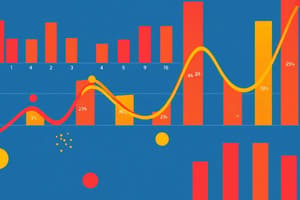Podcast
Questions and Answers
The ______ represents what percentage students got correct on the exam.
The ______ represents what percentage students got correct on the exam.
mean
The middle number when the data is arranged in ascending order is known as the ______.
The middle number when the data is arranged in ascending order is known as the ______.
median
Percentiles divide the whole range of possible results into ______ groups.
Percentiles divide the whole range of possible results into ______ groups.
100
Quartiles separate the ranked data into ______ equal parts.
Quartiles separate the ranked data into ______ equal parts.
Understanding the strengths and weaknesses of each measure allows statisticians to choose the appropriate method based on specific ______.
Understanding the strengths and weaknesses of each measure allows statisticians to choose the appropriate method based on specific ______.
The difference between the largest and smallest values in the dataset is called the ______
The difference between the largest and smallest values in the dataset is called the ______
Standard deviation tells you how spread out your numbers are from their average value; it's calculated by taking the square root of the ______
Standard deviation tells you how spread out your numbers are from their average value; it's calculated by taking the square root of the ______
The arithmetic average of all the numbers in the dataset is known as the ______
The arithmetic average of all the numbers in the dataset is known as the ______
If the standard deviation is low, it means most values are close to the average; if high, many values are far away from the average. A lower standard deviation indicates a tighter distribution around the ______
If the standard deviation is low, it means most values are close to the average; if high, many values are far away from the average. A lower standard deviation indicates a tighter distribution around the ______
The ______ is the difference between the 75th and 25th percentiles of a dataset, indicating the spread of the middle 50% of the data
The ______ is the difference between the 75th and 25th percentiles of a dataset, indicating the spread of the middle 50% of the data
Study Notes
Descriptive Measures in Statistics
In statistical analysis, descriptive measures play a crucial role in summarizing and representing data. These measures help us understand and communicate information about a dataset more effectively. Some common descriptive measures include:
- Standard Deviation: This measure tells you how spread out your numbers are from their average value. It's calculated by taking the square root of the variance and is denoted as (\sigma) or s.
For example, imagine a group of students' test scores where the class average is 80. If the standard deviation is low, it means most students scored close to the average score; if high, many scored far away from the average score. A lower standard deviation indicates a tighter distribution around the mean, while a higher one suggests a wider dispersion.
-
Range: The difference between the largest and smallest values in the dataset. It gives you an idea of the variability of the data without considering any central tendency. For instance, if we calculate the range for student grades in a class, it would equal the highest grade minus the lowest grade in the class, which can give us insights into how much variation there is within the set of scores.
-
Mean: The arithmetic average of all the numbers in the dataset. It represents the sum of all values divided by the total number of observations. In our student exams scenario, the mean would represent what percentage students got correct on the exam, assuming all students answered multiple choice questions with only one right answer per question.
-
Median: This is the middle number when the data is arranged in ascending order. Half the data values are less than the median, and half are greater than the median. In the context of grades, the median would indicate the point where half the students have scored below this value and half above it.
-
Percentiles: Percentiles divide the whole range of possible results into 100 groups, each containing the same number of people. These can be useful in comparing individuals because they show how someone did compared to others who took the test, rather than just telling you whether they passed or failed the exam.
-
Quartiles: Quartiles separate the ranked data into four equal parts. First quartile (Q1) is the 25th percentile, second quartile (Q2) is the 50th percentile (median), and third quartile (Q3) is the 75th percentile. They allow you to see what percentage of people did worse than them and what percentage did better than them.
Each of these measures provides different perspectives on the data. Understanding the strengths and weaknesses of each measure allows statisticians to choose the appropriate method based on specific needs, such as visualization, comparison, or inference.
Studying That Suits You
Use AI to generate personalized quizzes and flashcards to suit your learning preferences.
Description
Learn about key descriptive measures used in statistics to summarize and analyze data effectively, including standard deviation, range, mean, median, percentiles, and quartiles. Understanding these measures provides insights into the variability, central tendency, and distribution of a dataset.




